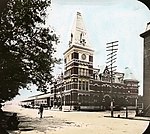Bust of Francesco Barberini
1620s sculpturesBusts by Gian Lorenzo BerniniBusts in Washington, D.C.Marble sculptures in Washington, D.C.

The Bust of Francesco Barberini is a marble sculpture by the Italian artist Gian Lorenzo Bernini, now in the National Gallery of Art in Washington, D.C. It was executed in 1623. It was commissioned by Pope Urban VIII, who was a nephew of Francesco Barberini, an apostolic protonotary. Francesco had died in 1600, so Bernini created the bust from an existing painted portrait. That portrait is in the Corsini Collection in Florence; Bernini made close use of the design, although the painting was a three-quarter portrait as opposed to a bust of head, shoulders, and upper body.
Excerpt from the Wikipedia article Bust of Francesco Barberini (License: CC BY-SA 3.0, Authors, Images).Bust of Francesco Barberini
Madison Drive Northwest, Washington
Geographical coordinates (GPS) Address Website Nearby Places Show on map
Geographical coordinates (GPS)
| Latitude | Longitude |
|---|---|
| N 38.89147 ° | E -77.02001 ° |
Address
National Gallery of Art
Madison Drive Northwest
20215 Washington
District of Columbia, United States
Open on Google Maps









